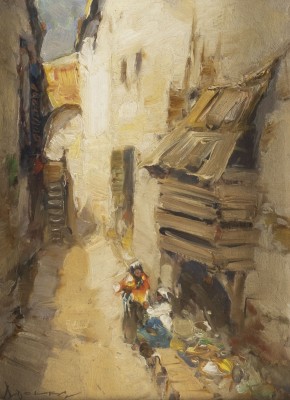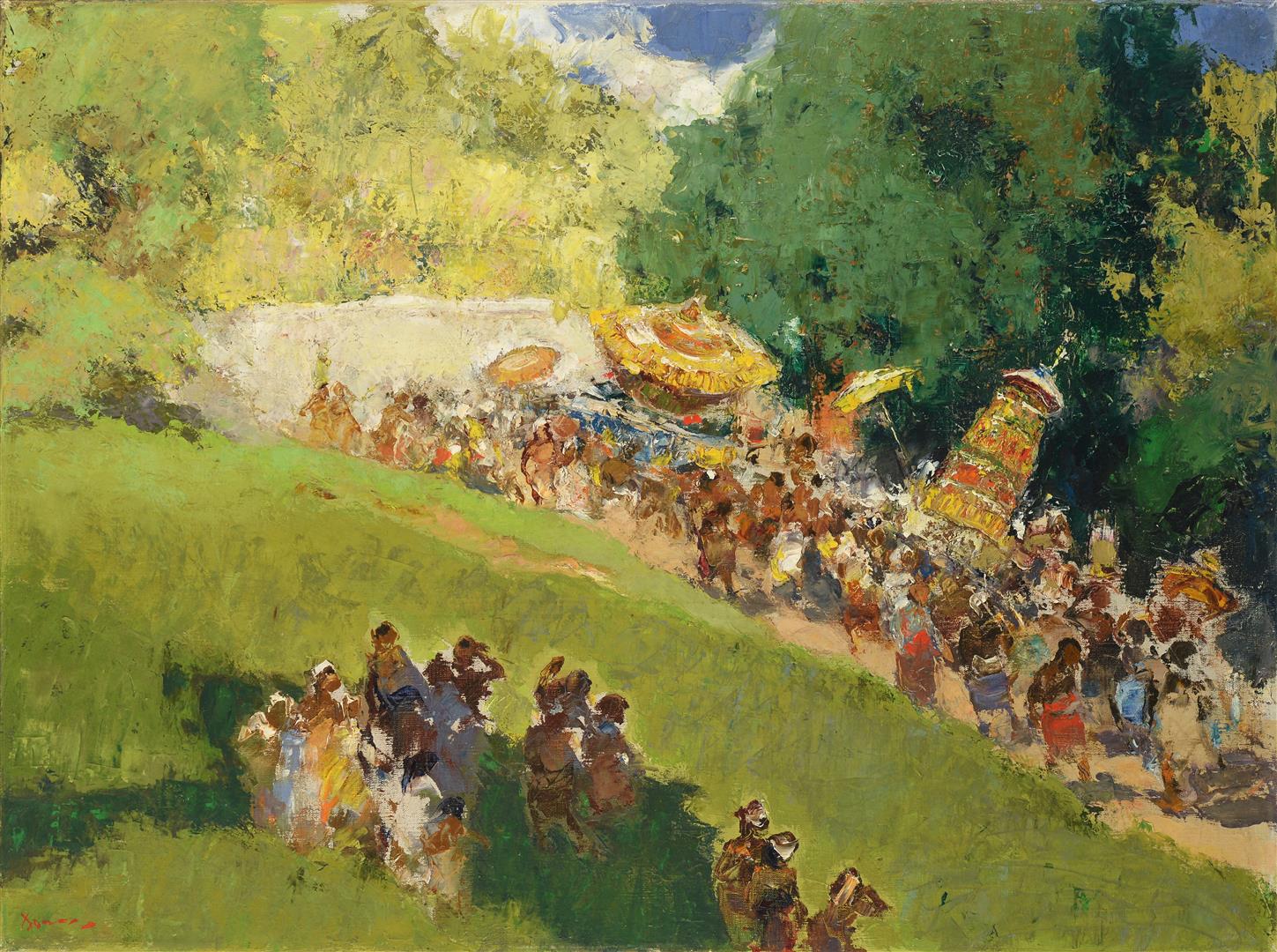'Hanenkamp met toeschouwers, Bali' / Cockfight with spectators, Bali signed 'Adolfs' (lower left); signed and dated again, titled and numbered 'no. 740' (on the reverse) oil on canvas, 50x40 cm Literature: -E. Borntraeger-Stoll and G. Orsini, 'Gerard Pieter Adolfs (1898-1968), the painter of Java and Bali', Wijk & Aalburg 2008, full-page colour ill. p. 141, no. 740, and ill. p. 404 (oeuvre catalogue). Provenance: -From the estate of the artist. -Thence by descent to the granddaughter of the artist. In his Neo-Impressionist period, roughly spanning from 1946 until 1967, Gerard Pieter Adolfs would use a palette knife to apply paint to the canvas. Apart from that, his artistic choices became bolder; anatomy and faces became more abstracted, colours became more saturated. On the other hand, by doing so, the insinuation of tropical light and the dynamic character of the scenes he envisioned increased: “These works present a typically Oriental vision where shade and soft tonalities do not exist, where everything dances and whirls, where nature, people and objects are like motley spots of colour fading away into a blazing, all-absorbing light.” (De Gentenaar, 10 January 1950). 'Hanenkamp met toeschouwers, Bali' (Cockfight with Spectators, Bali) exemplifies this typically Oriental vision. It embodies the well-known traditional sport, in which gambling plays such an essential role. ‘Gambling (…) was generally considered to be the main attraction of cockfighting. For the Dutch and Indonesian governments this was one of the main reasons to outlaw the popular traditional sport. Another reason for banning cockfighting was a change in attitude with respect to cruelty to animals.’ (1). On the other hand, and contrary to what most people think, cockfights are not always a matter of life and death. On Bali, a water clock (penalikan) was often used when a fighting cockerel was temporarily ‘knocked out’. A coconut shell -with a hole in it- is placed in a vessel with water. When the cockerel does not get up before the complete sinking of the shell (which moment is announced by striking a small gong) he is considered beaten. (2) Moreover, these cockerels were highly esteemed, well-fed and pampered by their owners. The current impression by Adolfs of two fighting cockerels is one of ultimate battle, in which one attacks the other, both having razor-sharp cockspurs (taji) tied to their legs. Seated in the background are their respective owners, hoping their bets were right, and their own esteemed animal will remain unharmed. With this painting, Adolfs touched upon an ancient Balinese custom, catching the dynamic of the fight’s most intense moment. ‘Three Tjapils, Poerwodadi’, however, exudes a whole different atmosphere; there is a quiet, introverted, static feel about it, and the lack of light creates ominous contour shapes, which at the same time improve our understanding of the composition. The hats, which the title of the painting refers to, take center stage; they add to the mysterious expression of the scenery, and give us an idea of the orientation of the three faces, although none of the jongkok seated men’s faces are really visible. Upon closer inspection, one can distinguish the vendor on the left holding a black bird, while on the right side, several colourful birds are being shown from a basket, balancing on the vendor’s left arm. All in all, if we compare these two Neo-Impressionist paintings, made only one year apart, surely they have one thing in common: “Adolfs has fathomed the soul of the Javanese and Balinese people. He has vitalised and intensified his figures with no loss of tranquility. Perhaps that is the most striking characteristic of these canvasses: this silent activity, of posture rather than of motion, and of concentrated observation on an event rather than active participation in it.” (Hengeloosch Dagblad, 15 October 1949). (1) Donk, P. van, Indonesian Cockspur Cases, Kotak Taji, Bali Lombok Sulawesi Kalimantan, Hes & de
'Hanenkamp met toeschouwers, Bali' / Cockfight with spectators, Bali signed 'Adolfs' (lower left); signed and dated again, titled and numbered 'no. 740' (on the reverse) oil on canvas, 50x40 cm Literature: -E. Borntraeger-Stoll and G. Orsini, 'Gerard Pieter Adolfs (1898-1968), the painter of Java and Bali', Wijk & Aalburg 2008, full-page colour ill. p. 141, no. 740, and ill. p. 404 (oeuvre catalogue). Provenance: -From the estate of the artist. -Thence by descent to the granddaughter of the artist. In his Neo-Impressionist period, roughly spanning from 1946 until 1967, Gerard Pieter Adolfs would use a palette knife to apply paint to the canvas. Apart from that, his artistic choices became bolder; anatomy and faces became more abstracted, colours became more saturated. On the other hand, by doing so, the insinuation of tropical light and the dynamic character of the scenes he envisioned increased: “These works present a typically Oriental vision where shade and soft tonalities do not exist, where everything dances and whirls, where nature, people and objects are like motley spots of colour fading away into a blazing, all-absorbing light.” (De Gentenaar, 10 January 1950). 'Hanenkamp met toeschouwers, Bali' (Cockfight with Spectators, Bali) exemplifies this typically Oriental vision. It embodies the well-known traditional sport, in which gambling plays such an essential role. ‘Gambling (…) was generally considered to be the main attraction of cockfighting. For the Dutch and Indonesian governments this was one of the main reasons to outlaw the popular traditional sport. Another reason for banning cockfighting was a change in attitude with respect to cruelty to animals.’ (1). On the other hand, and contrary to what most people think, cockfights are not always a matter of life and death. On Bali, a water clock (penalikan) was often used when a fighting cockerel was temporarily ‘knocked out’. A coconut shell -with a hole in it- is placed in a vessel with water. When the cockerel does not get up before the complete sinking of the shell (which moment is announced by striking a small gong) he is considered beaten. (2) Moreover, these cockerels were highly esteemed, well-fed and pampered by their owners. The current impression by Adolfs of two fighting cockerels is one of ultimate battle, in which one attacks the other, both having razor-sharp cockspurs (taji) tied to their legs. Seated in the background are their respective owners, hoping their bets were right, and their own esteemed animal will remain unharmed. With this painting, Adolfs touched upon an ancient Balinese custom, catching the dynamic of the fight’s most intense moment. ‘Three Tjapils, Poerwodadi’, however, exudes a whole different atmosphere; there is a quiet, introverted, static feel about it, and the lack of light creates ominous contour shapes, which at the same time improve our understanding of the composition. The hats, which the title of the painting refers to, take center stage; they add to the mysterious expression of the scenery, and give us an idea of the orientation of the three faces, although none of the jongkok seated men’s faces are really visible. Upon closer inspection, one can distinguish the vendor on the left holding a black bird, while on the right side, several colourful birds are being shown from a basket, balancing on the vendor’s left arm. All in all, if we compare these two Neo-Impressionist paintings, made only one year apart, surely they have one thing in common: “Adolfs has fathomed the soul of the Javanese and Balinese people. He has vitalised and intensified his figures with no loss of tranquility. Perhaps that is the most striking characteristic of these canvasses: this silent activity, of posture rather than of motion, and of concentrated observation on an event rather than active participation in it.” (Hengeloosch Dagblad, 15 October 1949). (1) Donk, P. van, Indonesian Cockspur Cases, Kotak Taji, Bali Lombok Sulawesi Kalimantan, Hes & de













Try LotSearch and its premium features for 7 days - without any costs!
Be notified automatically about new items in upcoming auctions.
Create an alert